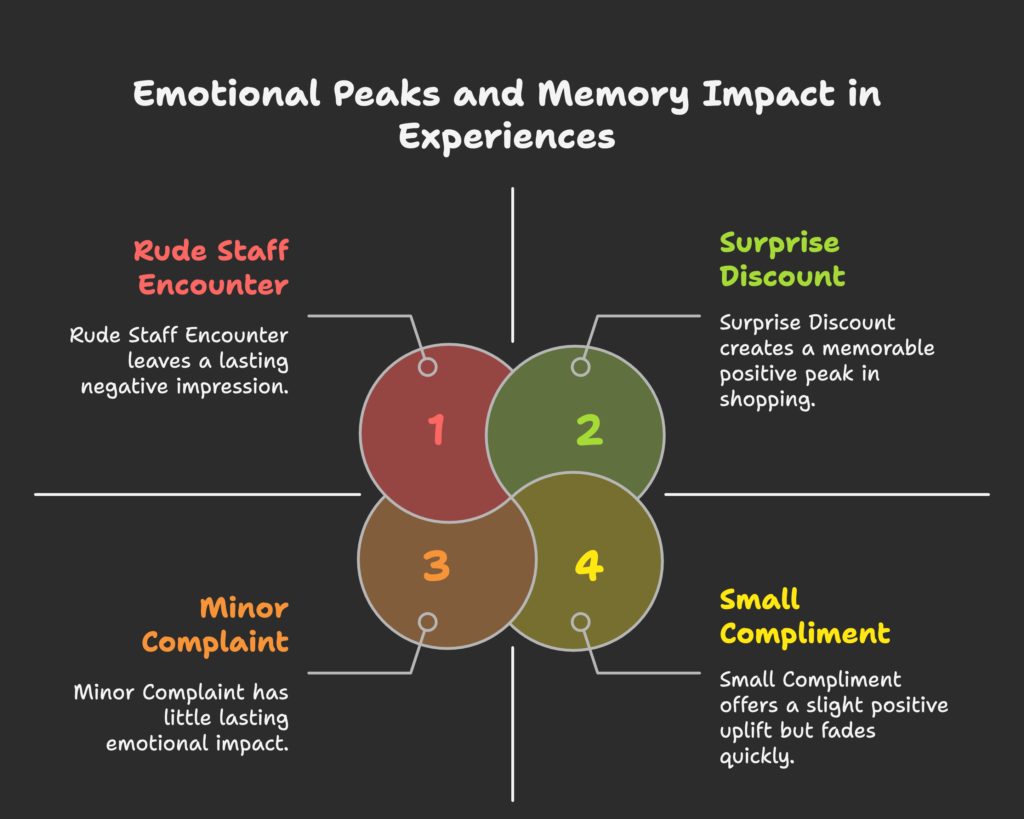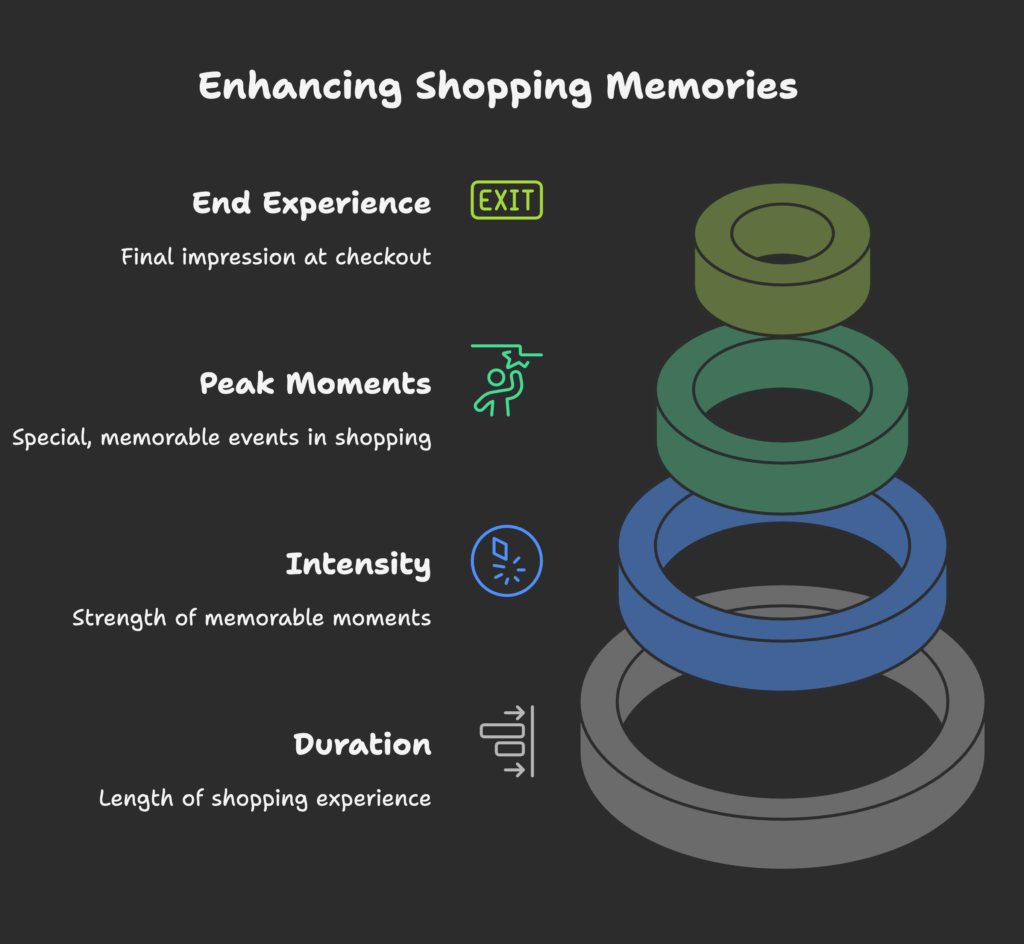Have you ever left a store feeling thrilled because of a single dazzling moment, or turned your back on a brand after a disappointing checkout experience? Surprisingly, our memory of an entire shopping experience often hinges on two specific points: the most intense (or “peak”) moment and the final impression. In this article, you will discover why these moments matter, how to design them for maximum positive effect, and how doing so can boost customer loyalty and sales. Ready to dive into the science of memorable retail experiences? Let’s begin!
In this section: We’ll define the Peak-End Rule, see how it came from Nobel Prize-winning research, and explore why focusing on peak moments and endings can transform customer satisfaction. You’ll learn how memory works in a selective and sometimes surprising way, and how retailers can use this knowledge to stand out.
Definition and Conceptual Framework
The Peak-End Rule states that people judge an experience primarily by its most intense point (the “peak”) and its final moments (the “end”), rather than by the entire duration. Daniel Kahneman’s research revealed we often remember an event’s highlights and its conclusion, ignoring everything in between. Evolutionarily, focusing on the best or worst points helps us learn from experiences quickly. For businesses, this effect means even if a customer’s experience is mostly average, a well-crafted peak and a satisfying ending can still leave them feeling delighted.
The Science of Memory and Shopping Experiences
Our brains aren’t perfect recording devices. Instead, we compile “highlight reels.” We give special weight to emotionally intense moments, whether they are positive or negative. This leads to “duration neglect,” where the overall length of an experience matters less than how it felt at its high or low points and how it ended. It’s why a short but deeply engaging retail visit can overshadow a long but bland one.
The Business Case for Understanding the Peak-End Rule
Multiple studies indicate that designing memorable high points and satisfying conclusions can significantly raise customer satisfaction and loyalty. In a saturated market, offering an ordinary, if efficient, experience may not be enough. By using the Peak-End Rule strategically, businesses can create a lasting impression, build stronger brand equity, and encourage repeat visits—all by focusing on these two key moments in a customer’s journey.
We’ve set the stage for the Peak-End Rule. Next, we’ll dive deeper into the psychology behind it, referencing key experiments and neurological factors that make these moments so crucial.
Psychological Foundations of the Peak-End Rule
In this section: We’ll explore the groundbreaking research that shaped the Peak-End Rule, the brain networks involved, and how emotions color our memory of shopping experiences.

Landmark Research and Experimental Evidence
Daniel Kahneman’s famed experiments, including studies on how people remembered discomfort (like cold water immersions or colonoscopy procedures), proved a strange fact: adding a little extra discomfort at the end of a bad experience—but making that discomfort less intense—could actually make participants rate the overall experience better. This is because the final, less-painful moments softened the ending, creating a more positive memory. Since then, other researchers have replicated these results in different contexts, solidifying the Peak-End Rule’s validity.
Neurological Basis for the Peak-End Effect
The amygdala, often associated with emotion, encodes peak emotional moments—whether joy or frustration. Meanwhile, hippocampal regions help consolidate these “peak” or “end” events into long-term memory. Neurotransmitters like dopamine (in rewarding peaks) or stress hormones (in negative peaks) increase the likelihood we’ll remember those instances. When we encounter a strong positive or negative emotion, our brain flags it as noteworthy, making it stand out in our mental replay of the experience.
The Role of Emotions in Experience Evaluation
Intense emotional arousal supercharges memories. Positive peaks (like an amazing surprise discount) stick around because they’re uplifting, while negative peaks (like a rude staff encounter) also linger. The *valence* (positive or negative) matters: a single negative peak can overshadow multiple smaller positives. Individual factors (like how emotionally sensitive a person is) further influence whether they’re more likely to recall a spike of delight or annoyance.
We’ve covered the research and brain science. Next, let’s see how these key insights apply specifically to shopping, from finding the best “peak” moments to designing memorable endings.
Key Components of the Peak-End Rule in Shopping Contexts
In this section: We’ll break down what exactly can become a “peak” in the customer journey, why the end is so critical (especially at checkout), and how the experience’s duration can fade in importance compared to its highlights.

Identifying Peak Moments in Shopping Journeys
Peak moments can come from anything that feels special: a captivating product demo, a hilarious staff interaction, a limited-time promotional event, or even a personalized gesture like the store manager learning a customer’s name. Critical contact points—like discovering a new item or testing a sample—can be engineered to be extra memorable. Note that what one person sees as a highlight may differ for another, so offering multiple potential peaks (sensory, emotional, social) is often wise.
End Experiences in Retail and E-commerce
Checkouts, both physical and online, often create the “final memory.” A breezy, engaging final step can uplift the entire experience, whereas a stressful or complex checkout can sour it. Post-purchase is also part of the ending: imagine receiving an instant “thank you” email or a surprise discount for next time. Even unboxing the product at home counts. If that last impression is strong (and positive), the overall memory remains sweet.
Duration and Intensity Considerations
The Peak-End Rule means the length of the experience is less influential than the intensity of key moments. A short shopping trip with a fantastic highlight can beat a long one with no real emotional spikes. On the other hand, ensuring at least one significant positive memory is essential, because a completely flat experience leads to an equally flat memory. Investing resources in designing strong peaks yields a higher return than just keeping customers in the store longer.
Next, let’s turn these principles into action by exploring real-world case studies and how retailers have leveraged the Peak-End Rule to their advantage.
Retail Applications and Case Studies
In this section: We’ll discuss how big names like IKEA apply Peak-End strategies, how e-commerce can replicate physical store peaks, and the importance of consistent experiences across multiple channels.
IKEA’s Strategic Implementation of the Peak-End Rule
IKEA intentionally designs its store journey to create multiple mini-peaks: the iconic showroom path, the “treasure hunt” marketplace, and the infamous cafeteria with affordable treats. The store exit (including the bistro for a quick snack) acts as a positive final note. This structure ensures you leave feeling satisfied, overshadowing any frustration from wandering those maze-like aisles. The results are clear: high brand loyalty and a positive memory that keeps shoppers coming back.
E-commerce Applications
- Peak Moments Online: Could be a flash sale, a playful product reveal, or a well-structured product demo video.
- Checkout & Confirmation: This is the digital “end.” A minimal friction checkout plus a delightful confirmation message can lock in a happy memory.
- Post-Purchase Emails: The experience doesn’t stop once the order is placed. A friendly follow-up with tracking info or tips on how to use the product can serve as a final positive note.
Removing negative peaks (like slow pages or hidden fees) is as crucial as building positive ones, ensuring the entire experience aligns with the Peak-End logic.
Multi-Channel Retail Experience Design
Customers jump between mobile apps, social platforms, and in-store visits, expecting consistency. If the online experience is wonderful but the store staff are indifferent, the overall impression suffers. Creating cross-channel synergy means making sure each platform offers a potential peak moment and a cohesive “end,” such as a quick checkout or an encouraging final call to action. When done right, the brand’s positive memory anchors can multiply across different channels.
Inspired by these examples? Next, we’ll focus on specific tactics to create peaks in store design, staff interactions, and product presentation.
Designing for Positive Peaks in Shopping Experiences
In this section: We’ll explore how to boost sensory elements, empower staff to deliver memorable moments, and use clever product interactions to create those intense bursts of delight that shoppers love.
Sensory Elements and Environmental Design
- Visual Merchandising: Eye-catching displays or theatrical layouts can spark a “wow” moment.
- Multi-Sensory Cues: Scents, background music, and comfortable lighting all layer onto the emotional experience.
- Space and Flow: Avoid clutter or confusion that might lead to negative peaks of frustration.
Even small touches like warm lighting in fitting rooms or a relaxing scent can be enough to create a memorable highlight.
Staff Interactions as Peak Creators
Frontline employees can make or break an experience’s peak. Training them to notice cues—like a confused expression or excitement about a product—allows for timely offers of help or enthusiastic suggestions. Service recovery also matters: turning a near-disaster into a moment of exceptional support can become a peak that outweighs the initial problem. Empathy, warmth, and genuine listening are key traits that amplify a staff-driven high point.
Product Interaction and Discovery Moments
Whether it’s letting customers test a VR gadget in-store or enabling them to sample an exciting new snack, interactive experiences produce emotional spikes. Showcasing a product’s “wow factor” with interactive displays or fun demonstrations can be a highlight of any retail visit. Make sure to keep these interactions easy and frictionless; the goal is to delight, not to overwhelm with complexity.
Now let’s see how you can optimize the all-important ending. Because no matter how great the rest was, if the final step is poor, that’s what sticks.
Optimizing End Experiences in Retail
In this section: We’ll detail how to streamline checkout, create impactful post-purchase moments, and handle negative endings to ensure the last memory is a positive one.
Checkout Process Optimization
- Queue Management: Perception of waiting time matters more than the actual wait. Engaging visuals or a small treat can sweeten the queue experience.
- Reduced Payment Friction: Clear instructions, multiple payment options, minimal forms—less stress means a better end note.
- Add a Bonus: A small discount or future perk at checkout can be a final, feel-good moment.
Think of checkout as the store’s “grand finale.” A quick, simple close leaves a wonderful last impression, overshadowing any minor hiccups earlier.
Post-Purchase Experience Design
Even after leaving the store or clicking “Buy Now,” the experience hasn’t truly ended. Send a heartfelt thank-you message or shipping update. With physical goods, packaging and unboxing can become the real “end,” especially for e-commerce. A well-designed box or surprise sample can excite customers. Follow-up communications—like surveys or tips—extend the sense of care and end on a high note.
Managing Negative Endings
Not every visit goes smoothly. If something goes wrong, a swift, sincere apology and proactive fix can flip a negative event into a peak of excellent customer service. This might involve a refund, a replacement, or a warm conversation that shows empathy. Handling complaints or returns gracefully can become a memorable finishing moment that paradoxically boosts loyalty.
Let’s move to measurement: how do we know if these peaks and endings really resonate with customers? Keep reading to find out!
Measuring and Optimizing Peak-End Experiences
In this section: We’ll examine ways to capture data on moments that stand out in a customer’s memory, from real-time emotional tracking to after-the-fact surveying.
Quantitative Assessment Approaches
- Experience Sampling: Asking customers about their feelings at various points during their visit or afterwards.
- Retrospective Evaluation: Surveys that specifically ask about the most memorable aspect and final impression.
- Emotional Intensity Tracking: Wearable or phone-based trackers that gauge spikes in arousal (though advanced, it’s emerging tech).
Comparing “moment-by-moment” feedback with overall memory can reveal whether you’re creating the intended peak or not.
Qualitative Research Methods
Customer journey mapping, interviews, and focus groups help pinpoint which parts of the experience left a real mark. Observing emotional reactions (like smiles or frustration) in-store or analyzing user session data online can highlight unintentional negative peaks or “wow” moments. Story-based feedback often uncovers which aspects truly linger in the mind.
Continuous Improvement Frameworks
Use iterative testing—like A/B tests—on different peak designs or end experiences. Track whether customers talk about these changes or whether they remain indifferent. Over time, refine your approach. Storing data in a central system helps compare results across different store locations or e-commerce variations, ensuring consistent improvement in shaping memory.
We’ve explored measurement. Now let’s turn to potential pitfalls, cultural variations, or ethical issues that might arise when trying to design experiences to influence memory.
Special Considerations and Challenges
In this section: We’ll address how the Peak-End Rule can vary across cultures and product categories, and discuss the moral questions around intentionally shaping customers’ memories.
Cultural and Demographic Variations
Some cultures might value calm, understated peaks, while others expect big, flashy events. Younger shoppers might want more visually stimulating or tech-heavy peaks, whereas older demographics could prioritize personal customer service. It’s crucial to adapt peak-end strategies to the local context and audience profile.
Category-Specific Applications
- Luxury Retail: Emotions run high, so a plush lounge or personalized greeting can serve as a strong positive peak.
- Grocery Shopping: Typically more functional, but quick and friendly checkouts plus small freebies can still create a positive ending.
- Service Industries: An extended experience may benefit from multiple mini-peaks to keep the energy up and end strongly.
Ethical Considerations in Experience Design
Some worry that orchestrating experiences can feel manipulative. The difference lies in whether you’re adding genuine value or merely hiding negative elements. As long as you’re honest about your products and delivering real benefits, shaping memory is more about good hospitality than trickery. Still, be mindful of user autonomy—avoid overshadowing real problems with artificial positivity.
Curious how to roll all of this into a full retail strategy? Our next section addresses how to systematically implement peak-end thinking at scale.
Implementation Strategy for Retailers
In this section: We’ll guide you through auditing your current customer experience, bridging organizational gaps, and scaling up pilot programs that apply the Peak-End Rule for maximum impact.
Experience Audit and Opportunity Identification
- Map Out Journeys: Identify each step from store entry or website visit to exit, find potential peaks and endings.
- Prioritize Pain Points: Quickly fix negative peaks before designing positive ones.
- Competitive Analysis: Study how rivals create or miss peaks. Determine your unique angle to stand out.
Cross-Functional Implementation Approaches
The store layout, marketing promotions, and staff training all matter. Collaboration between merchandising, operations, and marketing ensures consistent peak-end experiences. Staff buy-in is crucial—if the entire team understands the plan, they can spontaneously amplify positive moments or correct negative ones.
Testing and Scaling Peak-End Enhancements
Try pilot programs in a few stores or as an online “beta” if you’re e-commerce. For instance, create a special add-on at checkout or new staff scripts for greeting. Measure results, refine, and then extend the approach across all locations or digital platforms. An ongoing feedback cycle cements these changes for long-term success.
We’ve laid out the practical how-to. Now let’s peer into the future—how technology and shifting consumer tastes might redefine the Peak-End Rule in retail.
Future Trends and Innovations
In this section: We’ll explore new tech that could enhance or alter the Peak-End dynamic, from AI personalization to VR experiences. We’ll also note how consumer expectations evolve, raising the bar for truly memorable encounters.
Technology-Enabled Experience Enhancement
- AI Personalization: Predict which peaks a customer is likely to enjoy and tailor experiences accordingly.
- AR/VR Intensification: Virtual product trials or immersive experiences can create emotionally charged peaks.
- IoT for Real-Time Adjustments: Sensors detect emotional responses, adjusting lighting, music, or staff interventions on the fly.
Evolving Consumer Expectations
As more brands incorporate the Peak-End Rule, shoppers may come to expect a highlight in every store or site visit. Over time, these “wow” levels might rise, pushing retailers to continuously innovate. Sustainability and ethical considerations will also weave into peak experiences, as many modern consumers desire more than just fun—they want responsible, meaningful interactions.
Emerging Research Frontiers
Future studies could delve into how memory of a brand’s experiences accumulates over multiple visits or purchases. Cross-cultural research can clarify universal versus local aspects of the Peak-End Rule. Also, linking happiness research with business results might show how these memorable moments enhance not just sales but also employees’ and customers’ well-being over time.
You’ve got the vision for the future. Let’s now consolidate the big takeaways, present a step-by-step roadmap, and highlight how these ideas tie together for a winning strategy.
Conclusion and Key Takeaways
In this section: We’ll wrap up the essential Peak-End concepts for retail, provide a plan for incorporating them, and examine how this approach nurtures happier, more loyal customers and a stronger brand.
Synthesis of Peak-End Principles for Retail
- Focus on High-Impact Points: Identify the emotional “peaks” and pay special attention to the final touchpoints.
- Balance Good with Good Endings: End on a pleasant note—like quick checkouts or a thoughtful follow-up—can override any mid-experience boredom.
- People Remember Emotion: A big chunk of lasting impressions come from how customers feel, not just the logic of the process.
Implementation Roadmap
- Audit Your Experience: Map the customer journey, locate potential peaks, identify negative endings, and measure their impact.
- Prioritize & Design Peaks: Choose strategic points to delight or surprise. Train staff or refine design elements to create emotional highs.
- Optimize Endings: Simplify checkout, add farewell freebies or messages, ensure a positive final note. Follow with timely post-purchase communications.
- Iterate and Measure: Use feedback, analytics, and possibly A/B tests to refine. Keep focusing resources on the moments that shape memory.
The Future of Memorable Shopping Experiences
As advanced tech emerges, from real-time emotional tracking to AI-driven personalization, the power to craft precise, unforgettable moments grows. The shift from purely transactional retail to truly transformational experiences is already underway. By consistently implementing the Peak-End Rule, retailers create emotional bonds that outlast fleeting price deals or basic convenience. Ultimately, it’s about forging a genuine connection and a memory that says, “That was wonderful—I’d love to do it again.”
Small Note: If you’re a Shopify merchant looking to boost your store’s memorability (and sales), check out the Growth Suite app. It streamlines the final steps of your customer’s journey and helps design impressive peaks, ensuring your brand stands out and sticks in your customers’ minds.
References
- Semantic Scholar. (2024, March 18). If you were happy and you know it, clap your hands! Testing the peak-end rule for retrospective judgments of well-being in everyday life. Link
- LinkedIn. (n.d.). Improve Customer Satisfaction with the Peak-End Rule. Link
- LogRocket. (2023, December 1). What’s the peak-end rule? How to use it to improve UX. Link
- NeuroSpot. (2019, July 3). The Peak-End – What drives customers’ memory of an experience? Link
- FlowMapp. (2024, January 1). Peak-end Rule in UX Design. Link
- Semantic Scholar. (2024, December 1). First impressions vs. The Peak-End Rule: Episodic evaluations in a service experience and the moderating effect of retrospective delay. Link
- Laws of UX. (2020, January 1). Peak-End Rule. Link
- Semantic Scholar. (2024, August 27). Experimental Verification and Further Reflection on the Peak-End Rule. Link
- LinkedIn. (2024, January 3). Peak-End Rule in Product Design and Business. Link
- Semantic Scholar. (2023, April 12). Peak-end rule in narrative videogames… Link
- Semantic Scholar. (2022, December 14). A Study of Consumer Experience Enhancement in the Leisure Industry Based on Peak-End Rule: the Case of Atour. Link
- Semantic Scholar. (2025, January 14). Testing the peak-end rule in bumblebees… Link
- Paazl. (2022, March 24). The peak-end rule of e-commerce and why you should know it. Link
- Ombea. (2025, January 1). The Peak-End Rule: Unleashing the Science of Memorable Experiences in Retail. Link
- PubMed. (2021, April 19). Might High-Intensity Interval Exercise Be Remembered as More Pleasurable? An Attempt to Test the Peak-End Rule… Link
- Retail CX. (2024, April 30). Leveraging the Peak-End Rule in Retail Customer Experience. Link
- LinkedIn. (2023, July 17). Creating Customer Experience Magic With the Peak End Rule. Link




